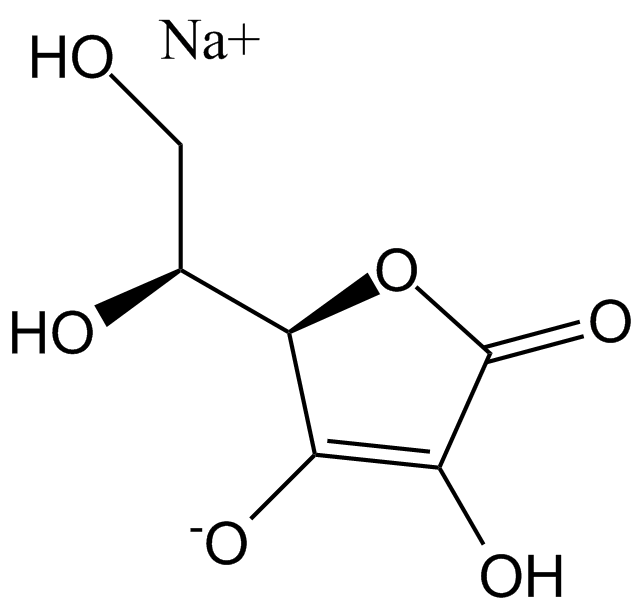Sodium ascorbate (Synonyms: Sodium L-ascorbate; Vitamin C sodium salt) |
| Catalog No.GC13616 |
Sodium ascorbate (Sodium L-ascorbate), an electron donor, is an endogenous antioxidant agent. Sodium ascorbate inhibits selectively Cav3.2 channels with an IC50 of 6.5 μM. Sodium ascorbate is also a collagen deposition enhancer and an elastogenesis inhibitor.
Products are for research use only. Not for human use. We do not sell to patients.

Cas No.: 134-03-2
Sample solution is provided at 25 µL, 10mM.
L-Ascorbic acid sodium salt is a more bioavailable form of vitamin C that is an antioxidant agent.
L-Ascorbic acid sodium salt, a known enhancer of collagen deposition, has also been identified as an inhibitor of elastogenesis[1]. The conditioned medium for B16F10 cells significantly inhibits cell apoptosis induced by sodium L-ascorbate (10 mM), and the effective ingredients in the medium show a relative molecular mass below 5,000[2].
Tg rats treated with sodium L-ascorbate show a higher incidence of carcinoma (29.6%), compared to those without sodium L-ascorbate (15.4%). Independent of the sodium L-ascorbate treatment, transgenic rats exhibit various kinds of malignant tumors in various organs[3]. After 12 weeks of PEITC-treatment, both simple hyperplasia and papillary or nodular (PN) hyperplasia have developed in all animals, but the majority of these lesions have disappeared at week 48, irrespective of the sodium L-ascorbate-treatment. The same lesions after 24 weeks of PEITC-treatment have progressed to dysplasia and carcinoma, in a small number of cases by week 48, but enhancement by the sodium L-ascorbate-treatment is evident only with simple hyperplasias and PN hyperplasias in rats[4].
References:
[1]. Hinek A, et al. Sodium L-ascorbate enhances elastic fibers deposition by fibroblasts from normal and pathologic human skin. J Dermatol Sci. 2014 Sep;75(3):173-82.
[2]. Yang X, et al. Mouse melanoma cell line B16F10-derived conditioned medium inhibits sodium L-ascorbate-induced B16F10 cell apoptosis. Nan Fang Yi Ke Da Xue Xue Bao. 2012 Feb;32(2):146-50.
[3]. Morimura K, et al. Lack of urinary bladder carcinogenicity of sodium L-ascorbate in human c-Ha-ras proto-oncogene transgenic rats. Toxicol Pathol. 2005;33(7):764-7.
[4]. Takagi H, et al. Limited tumor-initiating activity of phenylethyl isothiocyanate by promotion with sodium L-ascorbate in a rat two-stage urinary bladder carcinogenesis model. Cancer Lett. 2005 Mar 10;219(2):147-53.
Average Rating: 5 (Based on Reviews and 9 reference(s) in Google Scholar.)
GLPBIO products are for RESEARCH USE ONLY. Please make sure your review or question is research based.
Required fields are marked with *




















